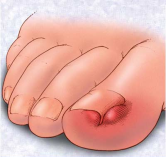
Nail Problems
Ingrown Toenails
Ingrown nails, the most common toenail impairment, are nails whose corners or sides dig painfully into the soft tissue of nail grooves, often leading to irritation, redness, and swelling. Usually
toenails grow straight out.
Sometimes, however, one or both corners or sides curve and grow into the flesh. Ingrown nails are varied in shape; some appear flat, others are C-shaped, a problem more commonly of older persons.
It's usually the big toe that's the victim, but other toes can be affected.
Ingrown toenails may be caused by:
- Improperly trimmed nails
- Shoe pressure; crowding of toes
- Repeated trauma to the feet from normal activities associated with work, sports, and other leisure-time or fitness pursuits
- Heredity
Podiatric Medical Care
If you suspect an infected toenail, you can immerse the foot in a warm salt water soak, or a basin of soapy water, then apply an antiseptic and bandage the area.
These are only temporary measures for relief of discomfort before you consult a podiatrist. Other "do-it-yourself" treatments, including any attempt to remove any part of an infected nail, and the use of over-the-counter medications, should be avoided.
Fungal and Other Infections
Toenails are hiding places for dirt and can serve as breeding grounds for infection-causing bacterial and fungal organisms.
Fungal infections are among the most troublesome of nail conditions to treat. There is often a separation of the front of the nail from the nail bed. In some cases, the nail crumbles.
If treatment with medication is unsucessful, the nail may be removed. However, removal does not necessarily prevent the nail from growing back, or fungal infection from recurring.
The information contained in this website is for educational use only and is neither intended nor implied to be a substitute for professional medical advice. Always seek the advice of your physician or other qualified health provider prior to starting any new treatment or with any questions you may have regarding a medical condition. Nothing contained within or pertaining to this site should be used for medical diagnosis or treatment.





